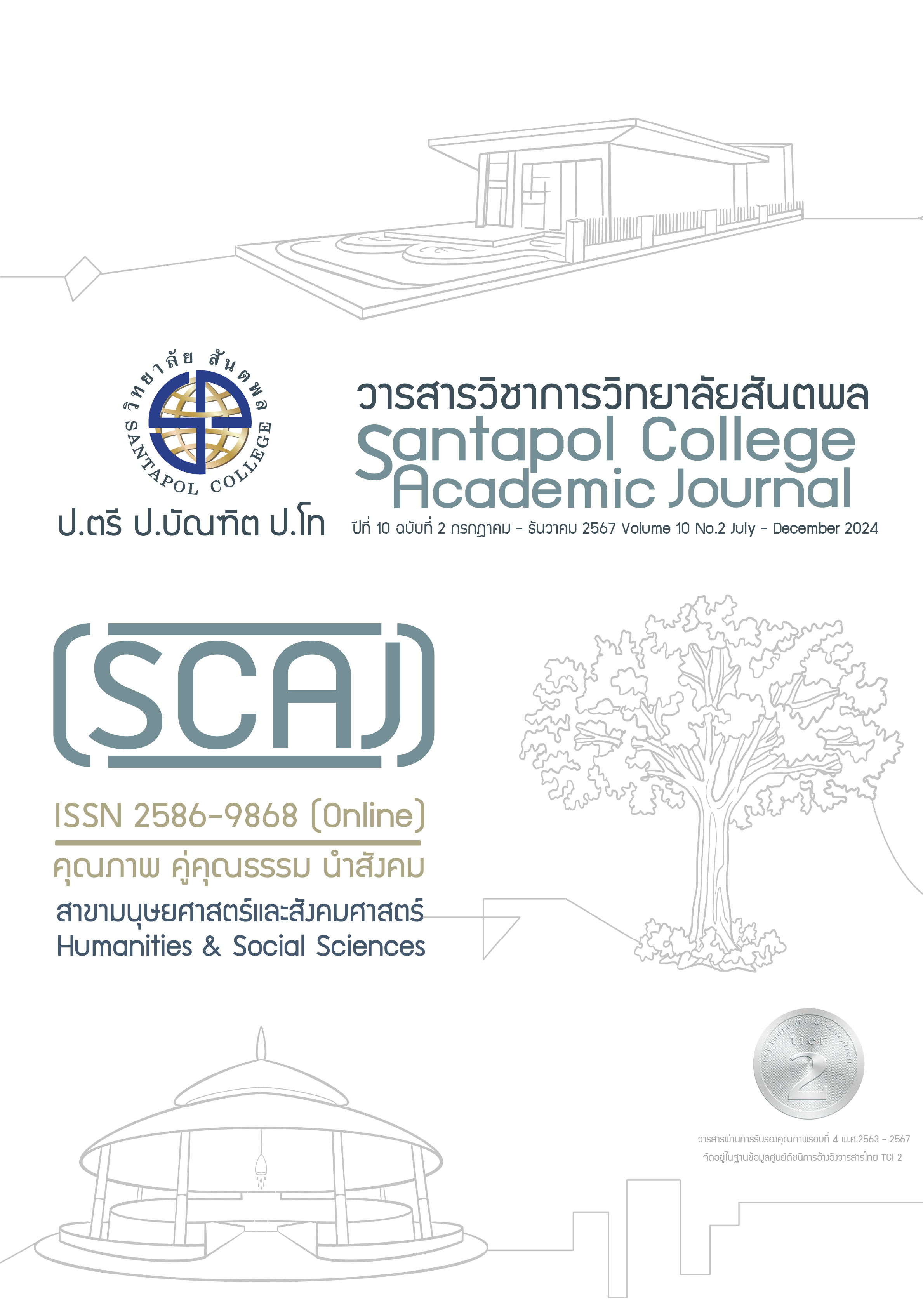ปัจจัยที่มีอิทธิพลต่อการสร้างกิจกรรมการละเล่นพื้นบ้านและกีฬาไทยให้มีอัตลักษณ์เพื่อการท่องเที่ยวเชิงวัฒนธรรมและประเพณี
Main Article Content
บทคัดย่อ
การศึกษาในครั้งนี้มีวัตถุประสงค์เพื่อศึกษาปัจจัยด้านการสร้างพื้นที่เพื่อการแสดงที่ส่งผลต่อการสร้างกิจกรรมการละเล่นพื้นบ้านและกีฬาไทยให้มีอัตลักษณ์ และศึกษาปัจจัยด้านการสื่อสารวัฒนธรรมที่ส่งผลต่อการสร้างกิจกรรมการละเล่นพื้นบ้านและกีฬาไทยให้มีอัตลักษณ์ ผู้วิจัยได้ทบทวนวรรณกรรมที่เกี่ยวข้องและได้ออกแบบเครื่องมือเป็นแบบสอบถาม โดยมีนักท่องเที่ยวเชิงวัฒนธรรมเป็นกลุ่มตัวอย่างจำนวน 400 คน เก็บข้อมูลจากการสุ่มแบบง่ายและวิเคราะห์ผลการทดสอบสมมติฐานด้วยวิธีการทดสอบการวิเคราะห์การถดถอยพหุคูณ (Multiple Regression Analysis)
ผลการทดสอบสมติฐาน พบว่า ปัจจัยด้านการสร้างพื้นที่เพื่อการแสดงที่ส่งผลต่อการสร้างกิจกรรมการละเล่นพื้นบ้านและกีฬาไทยให้มีอัตลักษณ์ อย่างมีนัยสำคัญทางสถิติที่ระดับ .05 เมื่อพิจารณาผลการวิเคราะห์สมการถดถอยพหุคูณ พบว่า ค่าสัมประสิทธิ์สหสัมพันธ์พหุคูณ (R) มีค่าเท่ากับร้อยละ 52.1 และมีค่า Adjusted R Square เท่ากับร้อยละ 32.1 และปัจจัยด้านการสื่อสารวัฒนธรรมที่ส่งผลต่อการสร้างกิจกรรมการละเล่นพื้นบ้านและกีฬาไทยให้มีอัตลักษณ์ อย่างมีนัยสำคัญทางสถิติที่ระดับ .05
เมื่อพิจารณาผลการวิเคราะห์สมการถดถอยพหุคูณแบบขั้นตอน พบว่า ค่าสัมประสิทธิ์สหสัมพันธ์พหุคูณ (R) มีค่าเท่ากับร้อยละ 68.1 และมีค่า Adjusted R Square เท่ากับร้อยละ 53.9
Article Details

อนุญาตภายใต้เงื่อนไข Creative Commons Attribution-NonCommercial-NoDerivatives 4.0 International License.
เนื้อหาและข้อมูลในบทความที่ลงตีพิมพ์ในวารสารวิชาการวิทยาลัยสันตพล ถือว่าเป็นข้อคิดเห็นและความรับผิดชอบของผู้เขียนบทความโดยตรง ซึ่งกองบรรณาธิการวารสารไม่จำเป็นต้องเห็นด้วยหรือรับผิดชอบใดๆ
เอกสารอ้างอิง
ขวัญชนก นัยจรัญ กฤษณา ชาญณรงค์ และเปรมวิทย์ วิวัฒนเศรษฐ. (2562). การศึกษามรดกภูมิปัญญาทางวัฒนธรรม ตำบลหนองกะท้าว อำเภอนครไทย จังหวัดพิษณุโลก. วารสารมนุษยศาสตร์ มหาวิทยาลัยนเรศวร, 16(3), 77-92.
คณะกรรมการส่งเสริมและรักษามรดกภูมิปัญญาทางวัฒนธรรม. (2560). การกำหนดลักษณะของมรดกภูมิปัญญาทางวัฒนธรรม พ.ศ.2560. สืบค้นเมื่อ 1 มีนาคม 2560 จาก http://ich.culture.go.th/images/stories/ich-pdf/160.pdf.
สรณัฐ ไตลังคะ. (2560). ศาสตร์และศิลป์แห่งการเล่าเรื่อง. พิมพ์ครั้งที่ 3. กรุงเทพฯ: มหาวิทยาลัย เกษตรศาสตร์.
Agmapisarn, C., Khetjenkarn, S., and Tachochalalai, S. (2020). A Study of Bangkok Street Food Consumption and Its Effects on Consumer Attitude and Behavioral Intention. Chulalongkorn Business Review, 42(1), 21-42.
Anwar, S., Ozturk, A.B. and Ibrahim, H. (2020). Cultural tourism: a review of the recent literature. Journal of Hospitality and Tourism Management, 43, pp.67-84.
Cochran, W.G. (1953). Sampling Techniques. New York: John Wiley & Sons, Inc.
Jonathan, G. and Michael, B. (2016). Of Mechanisms and Myths: Conceptualizing States’ “Soft Power” Strategies through Sports Mega-Events. Diplomacy & Statecraft, 27(2), 251-272.
Joonoh, J. and Jonathan, G. (2023). An analysis of Japan's soft power strategies through the prism of sports mega-events. Sport in Society, 26(10), p1756-1776. 21p. DOI: 10.1080 /17430437.2023.2197398.
Jun, A. (2023). Soft power is rare in world politics: Ruling out fear- and appetite-based compliance. Place Branding and Public Diplomacy, 19(4), 476-486.
Kotler , P. (2016). Marketing Management. 15th Edition New Jersey: Pearson Pretice Hall.
Ministry of Sport and Tourism. (2023). Statistics on sports tourists traveling to Thailand. Retrieved from https://www.mots.go.th/news/category/656. On 15 December 2023.
Rasoolimanesh, S. M., Jaafar, M., Kock, N. and Ramayah, T. (2019). Exploring the socio-cultural impacts of traditional sports and games: A case of rural tourism in Malaysia. Tourism Management Perspectives, 30, pp.78-90.
Singcram, P., and Thanaiudompat, T. (2023). “The Development of a National Sport Event Management Model that Affects the Value Added of the Sport Industry in Thailand,” Emerging Science Journal, 7(2), 445-454. Doi: 10.28991/ESJ-2023-07-02-010
Thanaiudompat, T. (2023). The Brand Values Development from The Customer’s Perspective in Sports Apparel Business in Thailand. Interdisciplinary Research Review, 18(2). Retrieved from https://ph02.tci-thaijo.org/index.php/jtir/article/view/248712
William, J. and Pawinpon, T. (2021). Muay Thai Diplomacy: Thailand’s Soft Power Through Public Diplomacy. Journal of Alternative Perspectives in the Social Sciences, 11(1), 99-123.


